Solutions To A Looming Crisis: Climate Change Challenges Creating
Further Complications For Nepal’s Mountain Farmers
By Sangeetha Rajeesh
01 March, 2014
Countercurrentsorg
With little or no support from authorities, mountain farmers of Nepal have been using traditional knowledge to come up with temporary home-grown solutions while combating climate change problems. While some of their ideas have worked, others have not been adequate to protect their crops from unpredictable changes in weather. Some farmers have had to abandon staple crops as a result, and make harsh decisions like turning to agriculture that is easier to cultivate.
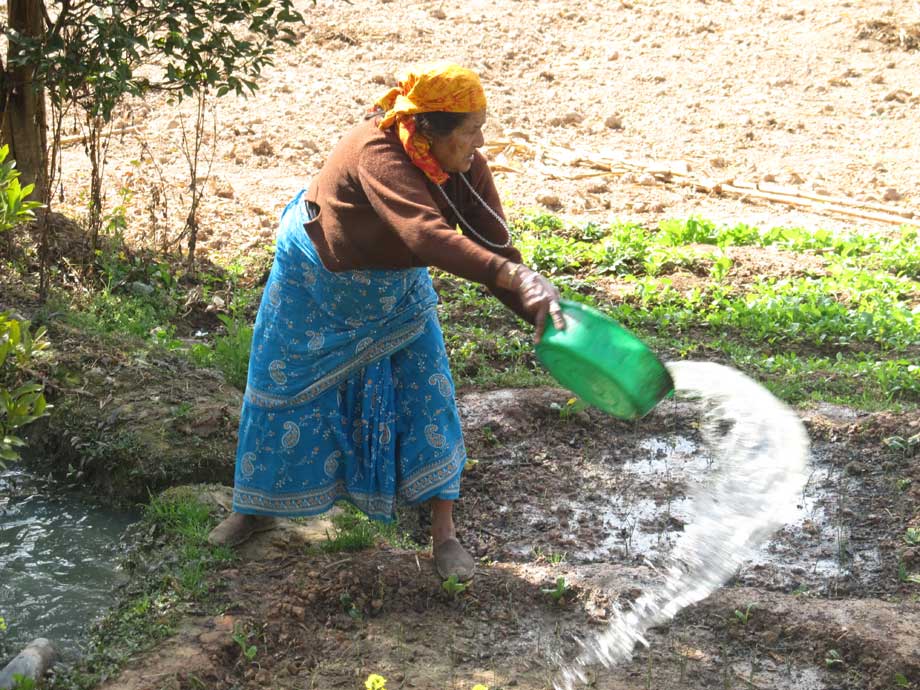
Chandramaya Humagi using household waste water for her onion bed in Panitanki village
Nepal: Chandramaya Humagi is busy with splashing muddy-looking water on her two-week old onion bed. She is 72 years old, and says that the family had had to adopt this technique of wetting their vegetable garden due to unpredictable rainfall.
In between her chores, Chandramaya tells us this - “Over the last few years, we’ve noticed that the weather is not the same,” she shares, “We find that it does not rain in the months it used to, and when it does rain, the quantity varies.” These sudden bouts of heavy showers were not only unpredictable in terms of timings, but also in the quantity of rainfall as well, prompting this septuagenarian to come up with an ingenious method to conserve water and recycle it for her vegetable fields.
“We began by collecting all our bathing and dish wash water, and now we collect even the waste water from washing our clothes,” she explains and pointing in the direction of a rather ruggedly dug pit in the middle of her fields, she adds proudly, “All waste water flows into a five feet deep pit that we have dug ourselves, which can store waste water for up to seven days!”
Women of the family take turns to spray the vegetable garden beds with this water once a week. They are a 6-member family and waste water collected has turned out to be a very useful and timely solution for their 15-day-old onions and garlic that they planted one month ago. “The problem is that we can only grow basic vegetables and in small quantities, particularly those that don’t need too much water,” worries Chandramaya. The vegetables they decide to plant with their limited water resource must have a good market price of course. “Sometimes,” she adds, “we have no other option but to leave part of our land fallow rather than invest in a crop and bear the loss.”
This farmer family had consciously decided to use household waste water because rain patterns changed, forcing them to alter their farming decisions. Rain Water Harvesting (RWH) would have been another way out and a more appropriate solution, but this family did not have any inclination about how it works.
Dr Bed Mani Dahal, Assistant Professor with Department of Environment Science & Engineering in Kathmandu University agrees that RWH and similar water conversion methods can help farmers deal with irregular rainfall patterns. Speaking of successful projects in Nepal where Rain Water Harvesting has been adopted, he shares, “Now-a-days, even in the hills, people have become conscious about storing rainwater, and is already in practise in the Terai region of Nepal.”
Dr Bed says that large rainwater drums have also been constructed in the region to store excess rain and this water is used for agriculture. “Just has how building up the mountain farmer’s resilience towards weather changes is very crucial, so also is the need to introduce water saving crops among them,” feels the Environment Professor, adding that better sharing of weather information and forecasting, climate change adaptation techniques and risk-reduction and management programmes for farmers will go long way in helping this community cope with shifting climate conditions and rainfall variability.
Changing climate, changing lives
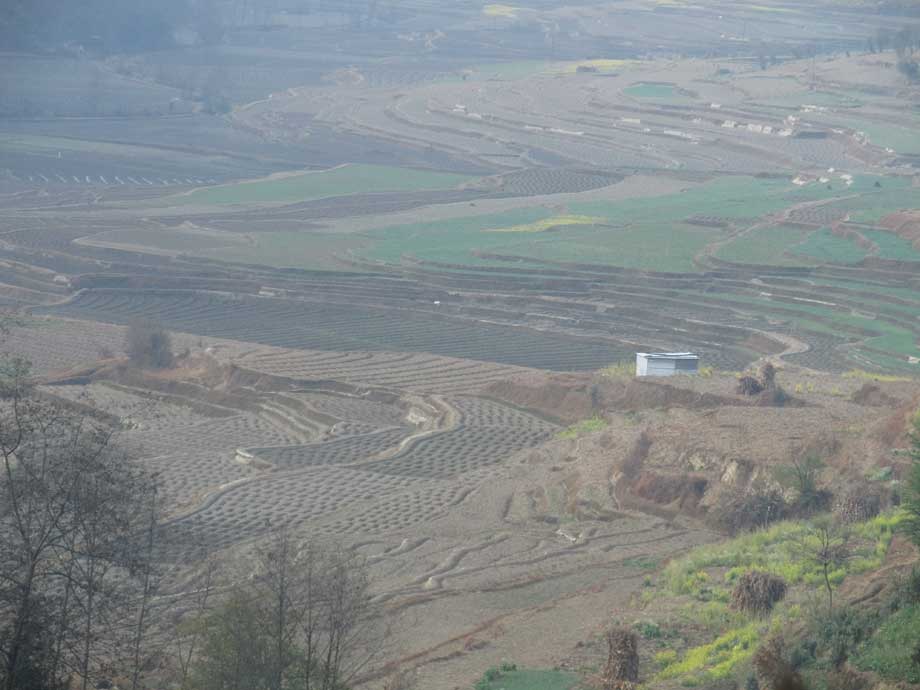
Farming in Nepal that was primarly used for paddy cultivation, now grows potato crop
Chandramaya is not the only one to be effected by changing climate in the mountains. Many farmers from the tiny Panityanki village in Kavrepalanchok District, about 35 kms from Kathmandu in Nepal, have learned to adapt to changes in weather by coming up with home-grown solutions, while others have simply changed the way they cultivate.
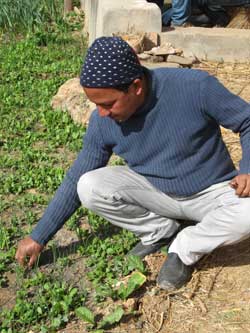 Take Bidur Basnet’s case for instance. He has always been a paddy farmer and his family is in agriculture for generations. Now Bidur cultivates vegetables in Panityanki village instead, and has given up rice agriculture. He explains why. “The weather has become very unreliable and unpredictable,” Bidur shares, “and as a farmer I must depend on the weather to decide what crop to cultivate when. This has always been the how I go about it.” He reminisces about how he used to know when the rains would start and when he could begin sowing. “But now, I am not sure because this has all changed.”
Take Bidur Basnet’s case for instance. He has always been a paddy farmer and his family is in agriculture for generations. Now Bidur cultivates vegetables in Panityanki village instead, and has given up rice agriculture. He explains why. “The weather has become very unreliable and unpredictable,” Bidur shares, “and as a farmer I must depend on the weather to decide what crop to cultivate when. This has always been the how I go about it.” He reminisces about how he used to know when the rains would start and when he could begin sowing. “But now, I am not sure because this has all changed.”
“I cannot prepare my fields for paddy without knowing what the weather is going to be like over the next few months; therefore I had to opt for a safer crop like vegetables,” he says. Bidur says his fear was that if he decides to sow paddy and if it did rain suddenly, it will flood his crop. “If the difference in weather changes were only small shifts, then it won’t matter too much for me, but there is a two-three month difference in the monsoon season! Such changes only mean heavy losses for me,” he explains.
Ramji Umangi’s story is no different. “All my previous generations have been farmers on this very same land,” he declares proudly while talking of his many years in agriculture. His 60-plus-years experience has made him an expert in predicting the perfect timing a farmer needs to sow and reap a good harvest.
“We’ve been having less and less rainfall every year, and so naturally we’ve begun to notice more pests,” he observes. “Farmers including myself are forced to use chemical pesticides, particularly for cauliflower and cabbage crops, to keep the pests at bay.” This is the only way, he says, he can be sure that the pests will die quickly and his crop will be saved.
Ramji’s fears are confirmed. Dr Bed Mani Dahal opines that rainfall changes do have an impact of pest rise and fall. He says, “There is a distinct possibility that less rainfall allows for rising temperature, and this is bound to encourage an increase in pest population.”
According to Nand Kishor Agrawal, Programme Coordinator for the research project HICAP (Himalayan Climate Change Adaptation Programme) at the International Centre for Integrated Mountain Development (ICIMOD), Nepal, “Globally, mountains are climate hotspots since rising temperatures are much higher and as expected, problems come with these changes.” He thus suggests that farmers should use natural pest predators instead of chemical-based pesticides to tackle the issue.
HICAP is an initiative that is looking at identifying long term solutions in the Hindu Kush Himalayan region by linking climate science research knowledge with the experience of farmers and communities who are already facing the consequences of climate change.
The former Mayor of Dhulikel Municipality, Kavre District Bel Prasad Shrestha feels that the Nepal’s farmers must continue their traditional agricultural practices. “Nepal was a country that used to produce a lot of grain and we even used to export, but today it is the other way around.” During his 16-year mayorship, despite a lot of money being spent of infrastructure development, he says that environment protection was also given priority. He is aware that the rainfall pattern is a little different and firmly believes that the traditional practice of organic farming and conventional methods of dealing with pests and changing weather will go a long way in preventing severe crop loss.
Climate changes – consequences & adaptation
Experts in the field have maintained that temperature variations are normal and that the earth’s climate systems (including air pressures, temperatures and precipitation) are not static. Speaking on the changing weather patterns on a global level, Senior Climate Change Adaptation Specialist, Valdemar Holmgren who is with the International Centre for Integrated Mountain Development (ICIMOD) based at Kathmandu, Nepal, says that weather conditions produced include variations of all kinds that happen now and again all over the world.
“The winter weather of mid-hills in Nepal are subject to the influence of several climate systems, but primarily from the continental high-pressure system that forms over central Asia, the Tibetan Plateau, and Siberia,” explains Valdemar, adding that the winds and temperatures that originate as far away as eastern Arabia and the eastern Mediterranean have influence as well. “The Himalaya Mountains also exert immense influence on regional and local ground conditions, and the day-to-day local weather in different places,” he continues to explain, “and naturally, farmers throughout the Himalayas have learnt about these conditions over the generations and established a local agricultural calendar for sowing seeds, harvest, etc.”
However, mountain farmers are beginning to realise that their traditional agriculture knowledge and practises are facing challenges. Mohan Bahadur Chand is a Rainfall Variability Expert at Kathmandu University says that the “rainfall pattern is changing constantly,” but also adds that it is difficult to confirm whether rainfall in Nepal has increased or decreased.
Monsoon patterns are shifting noticeably compelling farmers to abandon major cash crops and seek alternatives including new crops that consume less water and have shorter growing seasons. “This is the happening because the monsoon rains have shifted from April to mid-June and some places in the Eastern part of Nepal, the summer monsoon now carry more rain,” Mohan informs. He goes on to explain that although more than 80 % of rainfall occurs in the summer season, the number of rainy days is reducing. “There is high intensity of rainfall within fewer days and every year, the number of rainy days is reducing by at least one-to-three days every season,” confirms Mohan.
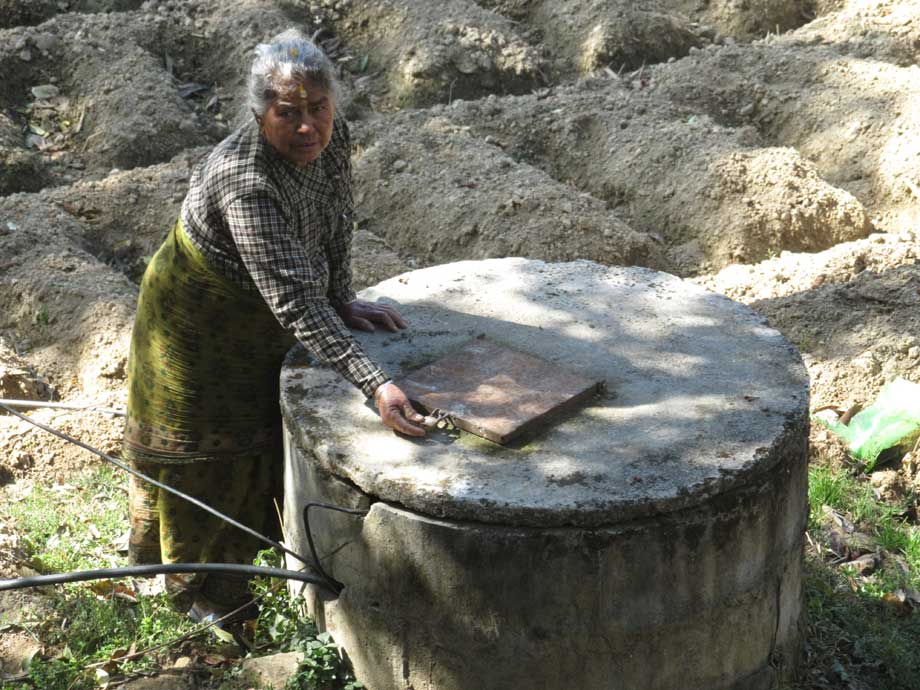
Malinli Karki is happy about this only source of water and is proud to be able to recycle it
Seventy-two year old Malinli Karki was working on her potato field when we met her. “We had to dig second time since we did not find water from our first tube well,” she informs. Malinli confirms that the well is 23 feet deep and is fitted with an electric motor that helps pump up water to her home. “It is all ground water and thankfully it runs dry for just three months in a year,” she smiles and adds, “We don’t waste any water. After we use it for household purposes, it is recycled for our vegetable garden eventually.” When all water dries up, the family do not cultivate anything on their lands, instead some male members of the family go out in search of wage labour as a temporary solution.
Malini’s fields use to have paddy too! With rainfall becoming unreliable over the last five years, she decided to cultivate potato vegetable in part of her land and leave the rest they leave fallow. “Growing water dependent agriculture has become risky and unviable due to delayed monsoons. But for vegetable, we wait for it to rain and then start cultivating. It is less risky,” she reveals. Thanks to her well, Malini is happy that she was able to at least cultivate potato.
However, Valdemar Holmgren of ICIMOD has another observation to share. As a climate change adaptation specialist, his research has been on the Koshi sub-basin and he believes that many farmers do not pay enough attention to agriculture like they used to do. “Frost is another major complaint from mountain farmers,” he shares, “but a few nights’ winter frost is normal in mid-hill areas.” Depending on the area placement i.e facing north would mean colder and south is warmer, altitude location and topography, frost will occur.
Farmer Ramji hopes that someday he will be able to afford environmental-friendly solutions to deal with this frost problem. “Plastic sheets can range from anything between NR 15, 000 and 20, 000, and are too expensive for a poor farmer like me,” he laments. These cover an area of about 12 meters length and five meters in width, and have to be perched permanently. “But it is nevertheless, a shield against harsh and now-a-days, unpredictable weather conditions,” Ramji feels.
Not every farmer in Panitanki is as lucky as Ganga. She owns four of these sheets and these she has used in a bid to protect her tomato harvest.
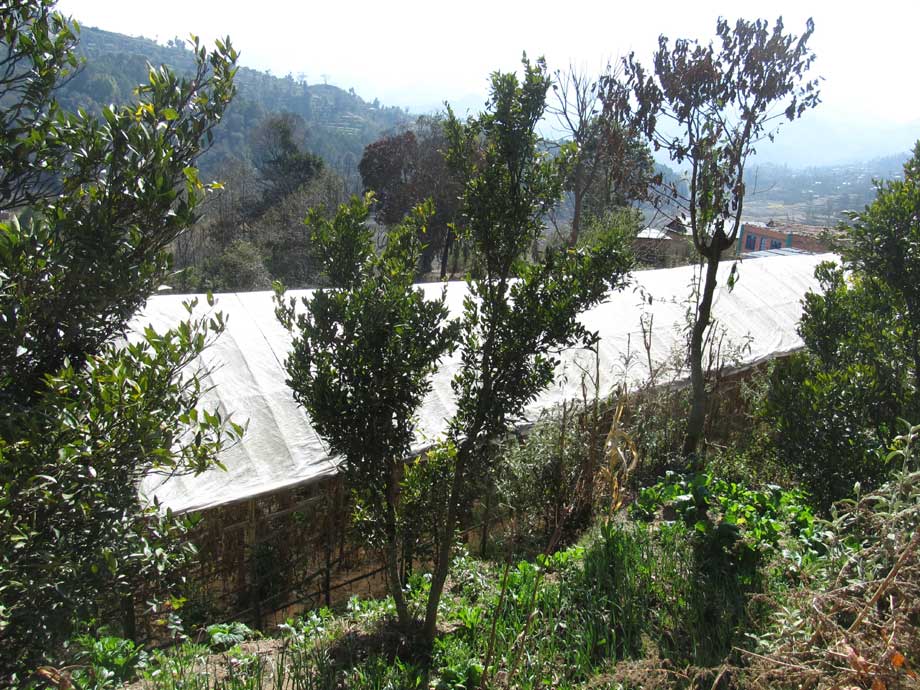
Plastic sheets Ganga uses in a bid to protect her tomato crop from frost
She lives with her family in Panitanki village and agriculture has always been a good livelihood source. “The plastic covers are most useful for about three months in a year, from mid-November,” she explains, “and we decided to invest in it thinking that it would prevent the tomato crop from being destroyed by frost.” Her husband works as Assistant Bank Manager in a nearby district and so she is able to afford this protective measure for her crops, but sadly, despite these plastic sheets, her tomato crop has been seriously affected by frost.
Ganga is sadden that despite toiling in the fields and having to adjust to changing weather conditions, Panitanki farmers are completely dependent on middlemen to get their produce to the markets. “The thekedar pays us only half of the market price, so we really loose by a huge margin. It is an added loss for us.”
In Valdemar Holmgren’s view, the plastic sheets used by the mountain farmer community “in this way do not offer a real solution to protect against frost.” Valdemar recommends that to protect against frost, crops should be “closely covered with vegetation together with plastic sheets for better protection” and not simply used as an open cover. However, the occurrence of surprise frost conditions is very hard for farmers to deal with.
He suggests that since there are now crops varieties of potato and tomato that can grow well in a mild winter, farmers should be advised accordingly and they should be planted in winter. “Mountain farmers should adapt soon because the risk of frost was always exists,” continues Valdemar, “Ground frost is a similar occurrence to morning dew on the ground at other times of the year and it is simply that the temperatures of air and ground are lower.”
BOX
Best measures to deal with frost in mountain regions
1. Avoid the risk of frost damage by waiting to plant tomato until there is no risk of frost
2. Avoid planting potato too early so the there is no stem and leaves above ground until February 1
3. Listen to the elder farmers in the community about no frost-risk dates
4. If the risk of winter cropping is taken, have a good stock of vegetation, from crop residue such as grain stalks or hay to fully cover the crop beds with in the evening when it seems the temperature would drop to zero degrees and maybe lower.
Sangeetha Rajeesh is an independent development & environment journalist based in Chennai
Comments are moderated
